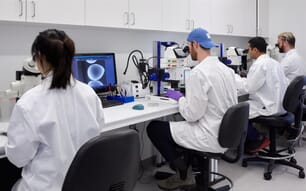Identity
Penaeus indicus H. Milne Edwards, 1837 [Penaeidae]
FAO Names: En - Indian white prawn, Fr - Crevette blanche des Indes, Es - Langostino blanco de la India
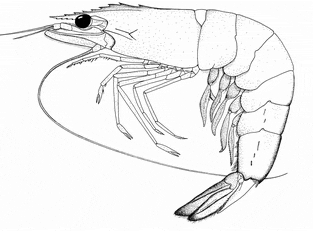
Biological features
Carapace rather smooth, lacking gastrofrontal and hepatic crests; adrostral crest extending as far as or just before epigastric tooth; rostrum slightly curved at tip and sigmoidal-shaped, usually bearing 7 to 9 upper teeth (including those on carapace) and 3 to 6 lower teeth; rostral crest generally slightly elevated in large specimens including adult females (but still with crest in females slightly higher than in males); postrostral crest extending near to posterior margin of carapace; gastro-orbital crest distinct, extending over posterior 3/5 distal 2 to 2/3 of distance between hepatic spine and orbital margin.
In adult petasma males, third maxilliped with distal segment about as long as second (ventral view) segment which bears a tuft of dense long hairs (same length as distal segment) attip. Petasma of males with distomedian projections strongly curved and overhanging distal margin of costae.
Thelycum of females formed by 2 semi-circular lateral plates, with their median margins forming tumid lips; anterior process slightly rounded and slightly convex; posterior process elongated and inserted between anterior part of lateral plates; both anterior and posterior processes rather distinct. Telson lacking lateral spines.
Colour: body semi-translucent, somewhat yellowish white (small specimens) or greyish green and covered with numerous minute dark brown dots; eyes light brown and covered with some dark brown mesh-like stripes; rostral and abdominal dorsal crests reddish brown to dark brown; antennal flagella yellowish; antennular flagella of same colour as body and covered with many dark spots; legs translucent and somewhat whitish, pleopods yellowish to pinkish; distal part of uropods yellowish with red margins. Size: Maximum body length 23 cm (females) and 18.4 cm (males), usually less than 17 cm.
Profile
Historical background
Traditional methods of brackish water aquaculture exist in four maritime states in India, namely West Bengal, Kerala, Karnataka and Goa. In Kerala, on the southwest coast of India, traditional shrimp farming is practiced with one crop of salt tolerant paddy during the rainy season (June to September) and one crop of shrimp during the summer season (November to April). These ponds are tidal; auto-stocking of mixed varieties of shrimp and fish takes place during high tide. Average total production is 650 kg/ha/yr, the proportion of shrimp being 71 per cent.
Within the shrimp harvest, Indian white prawn constituted 36-43 per cent. Juveniles completely depend upon natural food and harvesting is periodical, during full and new moon periods. Commercial shrimp farming, with selective stocking of shrimp seeds, was initiated with the establishment of shrimp hatcheries in the government and private sectors in India in he late 1980s; these hatcheries produced Penaeus indicus and Penaeus monodon seeds. In India, P. indicus farming has had to take a back seat due to farmers’ preference for P. monodon. The contribution of P. indicus to global farmed shrimp production is small – about 1.2 per cent in 2005. Currently P. indicus is mainly cultured in Saudi Arabia, Viet Nam, Islamic Republic of Iran, and India.
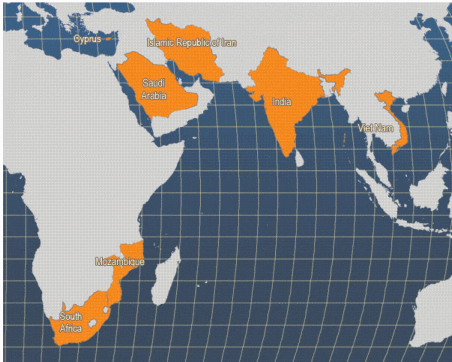
Habitat and biology
The Indian white prawn inhabits the coasts of East Africa, South Africa, Madagascar, the Gulf, Pakistan, the Southwest and East coast of India, Bangladesh, Thailand, Malaysia, Philippines, Indonesia, Southern China and the Northern coast of Australia. P. indicus is non-burrowing, active at both day and night, and prefers a sandy mud bottom.
Adults are normally found at depths less than 30 m but have also been caught from 90 m. The shrimp mature and breed mostly in marine habitats and spend the juvenile and sub-adult stages of 30 to 120 mm total length (TL) in coastal estuaries, backwaters or lagoons. Juveniles can tolerate a much wider range of salinity (5-40‰) than adults.
On the southwest coast of India the juveniles support a good commercial fishery in the backwaters and paddy fields. Geographic variations in size at first maturity are evident and vary from 130 to 149 mm TL. P. indicus females are highly fecund, ranging from 68 000 to 1 254 200 eggs from females of 140-200 mm TL.
There are five stages in ovarian maturation: immature, early maturing, late maturing, mature and spent. P. indicus belongs to the closed thelycum group and mating takes place immediately after the females moult. During mating, which normally occurs at night, the sperm packs (spermatheca) are deposited by the hard-shelled male into the thelycum of the newly moulted, soft-shelled female. The females carry the spermatheca during ovarian maturation and the sperms are dispensed at the time of spawning.
Fertilisation is external as the ripe ova released by the female become fertilised by the sperm extruding simultaneously from the stored spermatheca in the thelycum. Depending upon the temperature, hatching takes place within 8-12 hours after spawning. The nauplii are free swimming and non-feeding and pass through six moults. The larvae further pass through protozoea (3 stages), mysis (3 stages), and then to postlarvae, which resemble the adult shrimp. The postlarvae migrate into the estuaries, settle and feed on benthic detritus, polychaete worms and small crustaceans, and remain there until they attain 110-120 mm TL. These sub-adults then return to the sea and get recruited into the fishery.
Production
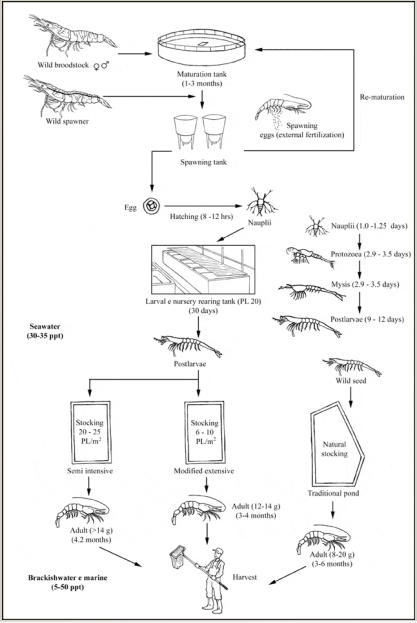
Production systems
Seed supply
In the traditional paddy-cum-filtration systems, juveniles congregating around the sluice gate are allowed to enter into the extensive fields during high tide. Earlier, wild seeds were also caught and sold to shrimp farmers. However, with the establishment of hatcheries and also due to overfishing, the dependence on wild seeds has been reduced.
Broodstock
Shrimp spawners for breeding purposes can be sourced either from the shrimp fishing grounds or can be developed in captivity by induced maturation of the adult specimens brought from the wild (>145 mm TL) and maintained in broodstock holding tanks. When wild spawners are used, they are carefully transported to the hatchery and maintained in flow-through systems in order to recover from the stress. The females are transferred individually in 500-1 000 litre cylindroconical fibreglass reinforced tanks containing microfiltered and sterilised seawater of 30-35‰ salinity and at pH 8.0-8.2. A temperature range of 27-31 ºC is ideal for spawning, which takes place during the night, following which the spawners are removed and transferred to rematuration tanks.
The size of P. indicus used for broodstock development should preferably be above 145 mm TL (20 g) for females and 140 mm (17 g) for males. The specimens, after a prophylactic treatment with 100 ppm formalin for 30 minutes, are stocked at 4/m³ and at a sex ratio of 1:1 in 100 tonnes circular tanks with an in situ biological filter. The tanks are covered and kept in a dark room. Three tanks of the above size can meet the broodstock requirements of a hatchery of 18 million capacity. Shrimp are fed with intertidal oligochaetes and clam and squid meat daily. Female eyestalks are unilaterally ablated by an electrocautery apparatus for endocrine stimulation.
Shrimp mature within 9-27 days after ablation and the interval between two consecutive spawnings may be 3-15 days. P. indicus also mature and spawn in captivity without eyestalk ablation by maintaining the pH between 8.0 and 8.2, light intensity below 500 lux and feeding with oligochaetes and fresh clam meat. However, ablated females produce ten, eight and six times as many spawns, eggs and nauplii, respectively, compared to unablated females.
Estimates of the total number of eggs spawned are made by sampling. The eggs are allowed to hatch in the same tank. After estimating the total number of nauplii hatched, they are collected, washed and stocked into larval rearing tanks. Small-scale hatcheries purchase the nauplii from nauplii producing centres for further rearing to postlarvae because broodstock maturation facilities require higher investments and infrastructure. Traders pack nauplii at a density of 20 000/litre; the technology to pack at a higher density of 100 000/litre has also been developed.
Hatchery production
Smaller indoor tanks of 2-5 tonnes capacity are used for rearing larvae up to PL3-5. Nauplii are stocked at 75-100/litre and fed on a mixed culture of diatoms dominated by Chaetoceros spp. or Skeletonema spp. The concentration of diatoms in the larval rearing tanks is always maintained above 20 000 cells/ml. From second or third mysis stage onwards, larvae are also fed on an egg-prawn-custard mixture with a 100-150 µ particle size, Artemia nauplii or microparticulate feeds. Larval rearing trials without the inclusion of the expensive Artemia nauplii have been successful but higher survival is achieved when Artemia is fed.
Nursery
The postlarvae (PL5) from each larval rearing tank are transferred into a nursery tank of 10 tonnes capacity for further rearing to PL20. From PL5 onwards, artificial diets are commonly used to reduce water quality deterioration. At a stocking density of 75 nauplii/litre, survival is estimated to be 75 per cent from nauplii to PL5 and 80 per cent from PL5 to PL20. Twelve larval cycles can be obtained in 8 months. PL20 postlarvae can be directly stocked into grow-out ponds for farming.
Ongrowing techniques
The culture practices followed are traditional, extensive, modified extensive, semi-intensive or intensive. Traditional farming practices are still practiced in tidal ponds along the Southwest coast of India. Commercial semi-intensive farming has been adopted in Middle Eastern and in the Gulf countries. Semi-intensive farming of P. indicus in some parts of India has been replaced by P. monodon, due to higher economic returns.
Traditional
This system of shrimp farming, which involves the trapping and holding of juvenile shrimp brought in by tidal water, is practiced in Bangladesh, India, Indonesia, Myanmar, the Philippines and Viet Nam. On the southwest coast of India, paddy fields ranging in size from 0.5 to 10 ha that are subject to tidal influence are auto-stocked with wild seeds of mixed varieties of shrimp and fish during November to April. These fields are seasonally used for a single crop of paddy during the monsoon season (June- September). Very large fields with deeper areas ranging in size from 2 to 75 ha, where paddy cultivation is impossible, are also used for shrimp filtration throughout the year. Shrimp feed on natural food in the ponds and shrimp production varies from 400 to 900 kg/ha/yr. P. Indicus forms 36-43 per cent of the total yield of shrimp.
Modified extensive
Ponds of 1 to 2 ha in size are constructed with separate inlet and outlet facilities on elevated sites to allow complete pond drainage. Ponds are fertilised with organic and inorganic fertilisers and seeds are stocked at the rate of 60 000-100 000/ha. The shrimp feed on natural foods enhanced by pond fertilisation, and supplemented by artificial diets. Water exchange of 10-15 per cent is carried out daily. A production of 1 000 to 2 500 kg/ha/crop is achieved in 3-4 months of culture.
Semi-intensive
Semi-intensive ponds are stocked with hatchery produced seeds at the rate of 20-25 PL/m². Water exchange is regularly carried out by pumping. 4-6 aerators/ha are used for maintaining desired levels of dissolved oxygen. Production levels of 2 500 to 5 000 kg/ha/crop are achieved.
Intensive
Intensive farming of P. indicus was first introduced when commercial shrimp farming was initiated in the late 1980s. The adopted stocking density was 50-100 PL/m². Feeding with artificial diets was carried out 4-5 times/day. Heavy aeration and water exchange to minimise environment deterioration was practiced. The production level achieved varied from 10 000 to 20 000 kg/ha/yr, while one entrepreneur claimed a production of 12 000 kg/ha/crop on the Southeast coast of India, This farming system is not in practice in India now. However, intensive systems are used in Saudi Arabia; a private company there has reported a production of 13 500 tonnes of P. indicus from a total pond area of 2 800 ha.
Feed supply
In India farmers use locally manufactured commercial shrimp feeds (not specifically designed for this species) as well as imported feeds designed for Penaeus monodon. Some farmers prepare their own feeds but these are qualitatively poor. The cost of imported feeds is generally higher. In Saudi Arabia, the National Prawn Company prepares feeds specifically for Penaeus indicus as it is exclusively culturing this species.
Harvesting techniques
In traditional farming, harvesting starts 2 months after stocking and is carried out from dusk to dawn for 7-8 days around every full moon and new moon period. Close-meshed conical nets are fitted to the sluice gates during low tide to harvest the stock. Final harvesting from extensive farming is carried out after 3-4 months of ongrowing. Water is drained out during low tide and further reduced by pumping, using mobile diesel-powered equipment. The remaining shrimp are harvested by cast netting. In modified extensive systems and semi-intensive systems, harvesting is carried out by complete draining of the pond, the shrimp escaping through the sluice gate being collected by bag nets. The remaining stock is harvested by hand picking. In Saudi Arabia, mechanical harvesting techniques are employed.
Handling and processing
Shrimp are washed, cleaned and weighed immediately after harvesting, before transfer to ice water at 0 ºC. The rectangular crates in which they are placed are then transported to the processing plants by insulated trucks. In the processing plants, the shrimp are cleaned and sorted into various grades to suit export requirements. Depending on market requirements, shrimp may be processed into several forms, such as simple block frozen, ready-to-eat, whole chilled, IQF, and cooked products, which are exported by container ship or air cargo. As part of the worldwide marketing strategy, major processors and exporters have adopted HACCP and ISO quality control systems.
Production costs
Production costs depend upon the site, the type of culture system, the scale of production, the number of production cycles per year, and the incidence of diseases, etc. The average seed production cost in India in 2000 was estimated to be about USD 1.6/1 000. The cost of adult shrimp produced in a modified extensive system was estimated in 1996 to be USD 4.20/kg but, as this species is no longer commercially reared in India (only extensively), no modern cost estimates are available. The production costs for this species, as reared in Saudi Arabia, are not available.
Diseases and control measures
The major disease problems for this shrimp species are shown in the table below. Viral infections cannot be treated by drugs but can be managed by screening for viral pathogens in broodstock and postlarvae by the PCR technique and by adopting good farming practices such as regulated stocking, feeding protocols and effective pond management. However, outbreaks of shrimp viruses may occur due to sudden changes in water quality and poor pond bottom environment
| DISEASE | AGENT | TYPE | SYNDROME | MEASURES |
|---|---|---|---|---|
| White spot (WSD) Also known as WSBV, WSSV or Whispo virus |
Part of the white spot syndrome Baculovirus complex | Virus | Severely affected shrimps lethargic; reduced feed consumption; body colour reddish with minute to large white spots embedded in cuticle; mortality within 3 to 10 days | PCR screening of broodstock, nauplii, PL & grow-out stages; avoid fresh feeds, minimise water or zero exchange to prevent virus carriers entering the pond; treat infected ponds or hatcheries with 200 ppm chlorine, disinfect associated equipment |
| Nuclear Polyhedrosis Baculovirosis Also known as Monodon baculovirus disease (MBV) |
Baculovirus | Virus | Lethargy; anorexia; epicommensal protozoan fouling | DNA based diagnostics using faecal matter of the wild broodstock; thorough washing of eggs & nauplii |
| Loose shell syndrome | Unidentified | Unidentified; suspected algal toxin | Reduced feeding & growth rate; lethargy; loose shell with space between cuticle & muscle; mortality | Good pond management |
| Cotton shrimp disease | Protozoans | Microsporidians | White opacity of musculature; lethargy; reduced feeding (not a major disease) | Removal of infected shrimps from pond |
Statistics
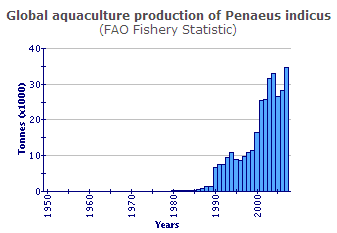
In 1990, only India and Viet Nam were reporting production of farmed Penaeus indicus to FAO and global production was just over 6 700 tonnes. By 2000, although the level of Indian production was similar, global production had more than doubled to over 16 400 tonnes, due mainly to the entry of Islamic Republic of Iranand (to a lesser extent) Saudi Arabia as significant producers, coupled with an increase in production from Viet Nam. Production in the Islamic Republic of Iran more than doubled between 2000 and 2005, while that from Saudi Arabia soared from just under 2 000 tonnes in 2000 to make it the largest producer in 2005 at nearly 11 300 tonnes. Production in Viet Nam also more than doubled in this period to an estimated 10 000 t in 2005. However, production in India declined markedly from over 5 200 tonnes in 2004 to 1 100 tonnes in 2005, due to the current preference for Penaeus monodon.
Market and trade
Products
The major products for export to Japan, US, the European Union and the Middle East are frozen (head-on, headless and peeled in block frozen form, IQF and AFD), chilled, together with several value-added products, such as shrimp pickles, cutlets, ready-to-cook and battered and breaded ready-to-eat. Sizes that are not suited for export are sold in the domestic market.
Prices and market statistics
White shrimp fetch a relatively lower price than Penaeus monodon. While the average C&F price for small headless P. monodon (21/25 size) in the US market was USD 7-13/kg (2001-2004), the average white shrimp price in 2004 was USD 5.5/kg.
Market regulations
Sanitary standards are high in all major importing countries, especially with regard to antibiotic and chemical residues. The European Union market has even higher specifications (zero tolerance). The market in the US enforces HACCP standards or Sensory Assessment and also imposes additional regulations regarding antidumping duties on imported shrimp and the application of Turtle Excluder Devices (TEDs) on wild shrimp fishing fleets in exporting countries.
Status and trends
Research
The following areas need intensive research:
- Efficient water management in closed grow-out systems.
- Selective breeding and domestication for genetically improved and SPF broodstock.
- Studies on loose shell syndrome and effective treatment and management protocols for shrimp viruses.
- Replacement of fish meal with ecofriendly feed ingredients.
Development
In Asian countries shrimp aquaculture used to be centred on the tiger shrimp Penaeus monodon. However, production has been affected due to a number of causes, including viral diseases, broodstock shortages, trade barriers and market competition. White shrimp species such as Penaeus indicus were ignored there, although high production rates could be achieved. However, the Islamic Republic of Iran and Middle Eastern countries prefer to culture this species because of its ability to grow in hypersaline conditions, its long-term growth pattern and the simplicity of hatchery-reared seed production. Many Asian countries shifted to Litopenaeus vannamei when problems arose with P. monodon as the former’s domestication and culture technology are much simpler; also, high production can be achieved, thus reducing production costs. Further expansion of the rearing of P. indicus is anticipated in the Islamic Republic of Iran and Saudi Arabia, but not elsewhere In Asia.
Market
The future market will be for organic shrimp and some private companies in countries like Saudi Arabia have already embarked upon the production of antibiotic-free quality P. indicus. Importing countries may impose more stringent quality standards, food safety certification and ecolabelling.
Main issues
In recent years, shrimp farming has generated considerable discussion and debate about its sustainability and environmental impact. The major issues are:
- Pollution of waterways and groundwater due to pond effluents.
- Loss of agricultural lands due to salinisation.
- Destruction of mangroves and misuse of wetlands.
- Social conflicts with other resource users.
- Increased dependence on fish meal for shrimp diets.
- Loss of biodiversity due to increased exploitation of wild seed and brooders.
- Introduction of exotic species.
Governments and the shrimp farming industry have implemented several measures to reduce these negative impacts. Improved water management practices, strict control over stocking density, prevention of the salinisation of groundwater and the application of precautionary and ‘polluter pays’ approaches are increasingly being applied, so that shrimp farming will become an ecofriendly activity. Many farmers are small-scale farmers with ponds of less than 3 ha in most of the Asian countries and it has been suggested that the establishment of common effluent treatment systems may assist them to improve. Rural employment opportunities and other infrastructure facilities increased with the establishment of shrimp farms.
Recommendations
Production costs in India need to be reduced and efforts to market the cultured shrimp in domestic markets at reasonable prices need to be promoted. Cooperative farming practices such as satellite farming would help to ensure proper management of the grow-out system, with arrangements to buy shrimp from smaller producers. Research should focus on developing genetically improved SPF and SPR broodstock for the production of fast growing and high health shrimp.
Responsible aquaculture practices
Due to the rapid development of shrimp farming, an increasing awareness of its potential impact on the environment developed. For example, India followed the directions if its Supreme Court (vide Gazette Notification No. 76 dated 6.2.1997), which established the Aquaculture Authority to ensure responsible aquaculture practices. The authority was entrusted with the responsibility of issuing licenses to shrimp farmers and the preparation of guidelines to promote sustainable shrimp aquaculture. As another example, Thailand has complied with the concept of responsible aquaculture in Article 9 of the FAO Code of Conduct. However, the implementation of certification and ecolabelling systems may take place more slowly because of the difficulties in tracing the origin of qualifying products from small-scale farms and hatcheries.
July 2010




